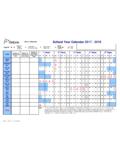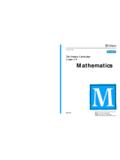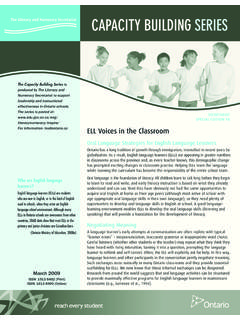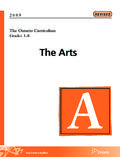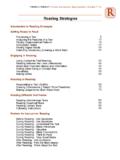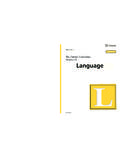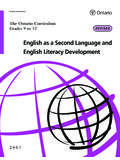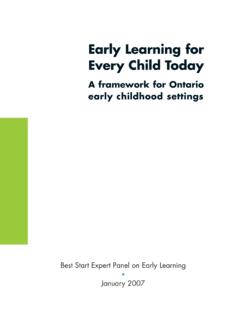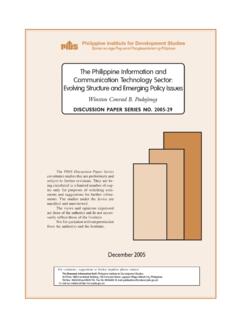Transcription of Science and Technology - Ministry of Education
1 2007 REVISED. The Ontario Curriculum Grades 1-8. Science and Technology CONTENTS. INTRODUCTION 3. The Goals of the Science and Technology Program .. 3. The Nature of Science and Technology .. 4. Roles and Responsibilities in the Science and Technology Program .. 7. THE PROGRAM IN Science AND Technology 10. Curriculum Expectations .. 10. Strands in the Science and Technology Curriculum .. 11. The Skill Continua for Scientific Inquiry and Technological Problem Solving .. 12. Topics in Science and Technology .. 19. ASSESSMENT AND EVALUATION OF. STUDENT ACHIEVEMENT 21. Basic Considerations .. 21. The Achievement Chart for Science and Technology .. 23. SOME CONSIDERATIONS FOR PROGRAM PLANNING. IN Science AND Technology 28. Instructional Approaches .. 28. Health and Safety in Science and Technology Education .. 29. Cross-Curricular and Integrated Learning .. 30.
2 Planning Science and Technology Programs for Students With Special Education Needs .. 30. Program Considerations for English Language Learners .. 33. Environmental Education .. 35. Antidiscrimination Education in the Science and Technology Program .. 36. Critical Thinking and Critical Literacy in Science and Technology .. 38. Literacy and Numeracy in the Science and Technology Program .. 38. The Role of Information and Communications Technology in Science and Technology Education .. 40. The Role of the School Library in Science and Technology Programs .. 41. Guidance in Science and Technology Education .. 42. Une publication quivalente est disponible en fran ais sous le titre suivant : Le curriculum de l'Ontario, de la 1re la 8e ann e Sciences et technologie, 2007. This publication is available on the Ministry of Education 's website, at THE CURRICULUM EXPECTATIONS.
3 Grade 1 .. 43. Grade 2 .. 57. Grade 3 .. 69. Grade 4 .. 83. Grade 5 .. 97. Grade 6 .. 111. Grade 7 .. 125. Grade 8 .. 139. GLOSSARY 152. INTRODUCTION. This document replaces The Ontario Curriculum, Grades 1 8: Science and Technology , 1998. Beginning in September 2008, all Science and Technology programs for Grades 1 to 8 will be based on the expectations outlined in this document. THE GOALS OF THE Science AND Technology PROGRAM. A scientifically and technologically literate person is one who can read and understand common media reports about Science and Technology , critically evaluate the information presented, and confidently engage in discussions and decision-making activities that involve Science and Technology . Science Co-ordinators' and Consultants' Association of Ontario (SCCAO). and Science Teachers' Association of Ontario (STAO/APSO), Position Paper: The Nature of Science (2006), p.
4 1. During the twentieth century, Science and Technology played an increasingly important role in the lives of all Canadians. Science and Technology underpin much of what we take for granted, including clean water, the places in which we live and work, and the ways in which we communicate with others. The impact of Science and Technology on our lives will continue to grow. Consequently, scientific and technological literacy for all has become the overarching objective of Science and Technology Education throughout the world. Achievement of both excellence and equity underlies the three major goals of the Science and Technology program at the elementary level. Accordingly, The Ontario Curriculum, Grades 1 8: Science and Technology , 2007 outlines the skills and knowledge that students will develop, as well as the attitudes that they need to develop in order to use their knowledge and skills responsibly.
5 The three goals are the following: 1. to relate Science and Technology to society and the environment 2. to develop the skills, strategies, and habits of mind required for scientific inquiry and technological problem solving 3. to understand the basic concepts of Science and Technology THE NATURE OF Science AND Technology . The primary goal of Science is to understand the natural and human-designed worlds. Science refers to certain processes used by humans for obtaining knowledge about nature, and to an organized body of knowledge about nature obtained by these processes. Science is a dynam- ic and creative activity with a long and interesting history. Many societies have contributed to the development of scientific knowledge and understanding. Scientists continuously assess and judge the soundness of scientific knowledge claims by testing laws and theories, and modifying them in light of compelling new evidence or a re-conceptualization of exist- ing evidence.
6 Technology involves the development and use of materials, tools, and processes for solving human problems and helping to satisfy human needs and desires. Many of the products of Technology help humans accomplish tasks that would otherwise be very difficult or impossi- ble to carry out. Although Technology provides many benefits, it also produces associated costs and risks. Science often uses and requires tools and processes developed by Technology , and conversely, Technology often employs principles, laws, theories, and processes devel- oped by Science . SCCAO and STAO/APSO, Position Paper: The Nature of Science (2006), pp. 1 2. Science is a way of knowing that seeks to describe and explain the natural and physical world. An important part of scientific and technological literacy is an understanding of the nature of Science , which includes an understanding of the following: what scientists, engineers, and technologists do as individuals and as a community how scientific knowledge is generated and validated, and what benefits, costs, and risks are involved in using this knowledge how Science interacts with Technology , society, and the environment Occasionally, theories and concepts undergo change but, for the most part, the basic ideas of Science ideas such as the cellular basis of life, the laws of energy, and the particle the- ory of matter have proven to be stable.
7 Technology is also a way of knowing, and is also a process of exploration and experimen- tation. Technology is both a form of knowledge that uses concepts and skills from other THE ONTARIO CURRICULUM, GRADES 1 8 | Science and Technology disciplines (including Science ) and the application of this knowledge to meet an identified need or to solve a specific problem using materials, energy, and tools (including computers). Technological methods consist of inventing or modifying devices, structures, systems, and/or processes. An understanding of the nature of Technology includes knowing the following: what Technology is, in its broadest terms (much more than the knowledge and skills related to computers and their applications). how Technology and Science are interrelated how thinking about Technology 's benefits, costs, and risks can contribute to using it wisely Science and Technology are closely linked, especially through the skills of scientific inquiry, technological problem solving, and communication.
8 The world as we know it today has been affected in many important ways by Science and Technology . For example, Science has radically altered and expanded our understanding of Earth and space, of the workings 4. of the human mind and body, and of the ways in which living organisms interact; and Technology has revolutionized the way we communicate and has made vast changes in our lives through the discovery of new drugs and materials. It is important, therefore, that students see Science and Technology in this wider context as endeavours with important consequences for people and other living things and that they learn to con- nect their knowledge of Science and Technology to the world beyond the school. Fundamental Concepts Fundamental concepts are key ideas that provide a framework for the acquisition of all scientific and technological knowledge. They also help students to integrate scientific and technological knowledge with knowledge in other subject areas, such as mathematics and social studies.
9 The fundamental concepts that are addressed in the curricula for Science and Technology in Grades 1 to 8 and for Science in Grades 9 to 12 are matter, energy, systems and interactions, structure and function, sustainability and stewardship, and change and continuity. As students progress through the curriculum from Grades 1 to 12, they extend and deepen their understanding of these fundamental concepts and learn to apply their under- standing with increasing sophistication. These fundamental concepts are described in the following chart. Fundamental Concepts Matter Matter is anything that has mass and occupies space. Matter has particular structural and behavioural characteristics. Energy Energy comes in many forms, and can change forms. It is required to make things happen (to do work). Work is done when a force causes movement. Systems and A system is a collection of living and/or non-living things and processes Interactions that interact to perform some function.
10 A system includes inputs, out- puts, and relationships among system components. Natural and human systems develop in response to, and are limited by, a variety of envi- ronmental factors. Structure This concept focuses on the interrelationship between the function or and Function use of a natural or human-made object and the form that the object takes. Sustainability Sustainability is the concept of meeting the needs of the present with- and Stewardship out compromising the ability of future generations to meet their needs. Stewardship involves understanding that we need to use and care for the natural environment in a responsible way and making the effort to pass on to future generations no less than what we have access to our- selves. Values that are central to responsible stewardship are: using non-renewable resources with care; reusing and recycling what we can; switching to renewable resources where possible.
